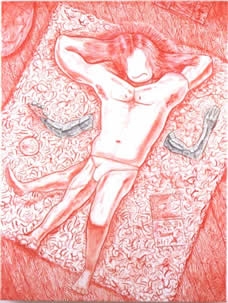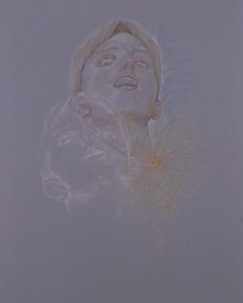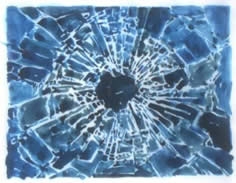Feature: Reviews
Guide to Trust No. 2
- Yerba Buena Center for the Arts
- San Francisco
- February 9 - April 21, 2002
Guide to Trust No. 2 featured an international group of artists who were invited by Belgian artist-run organization anp to “translate the ideas from [Dennis Cooper’s novel] Guide into a visual form.”
Asking artists to respond to a novel that exposes the incompetence of both language and art seems like a self-defeating concept, and in a lot of ways, it was. Many contributions did an excellent job of proving Cooper’s point that our systems of expression break down in the face of primal experience. But it was also a ridiculously masochistic concept, and in that respect, it followed from Cooper’s transgressive ideas quite naturally. It might even have been perversely appropriate.
Besides, another of Cooper’s points is that the art-is-futile argument, regardless of its validity, is a dark road leading to frightening places. Using that kind of logic this review is something like the third degree of pointlessness, and as Cooper’s “overeducated, spaced-out” artist character Scott says in a moment of acid-inspired clarity, “I can’t think art is pathetic, even if it is.”
The forty-odd artists in the exhibition took wildly divergent approaches to anp’s assignment. That the show was all over the place, aesthetically speaking, was not a problem. Guide itself is episodic, and Cooper spends a lot of time musing on various states of incoherence, so the structure echoed the novel fairly faithfully. But even making allowances for the arguably flawed premise, Guide to Trust No. 2 was a type of show that is hard to pull off. It was difficult for the artists to get past the Theme, to create anything more than a possible solution to a problem.
And since many works didn’t dig deeply enough to address Cooper’s specific theses (the futility of language being like the futility of total intimacy, sex leading logically to death because to literally get inside of someone you have to kill them, our need to communicate being deadly and refusing to be denied, and so on), you had was a show loosely assembled around issues of sex, love, death, and violence.
Cover Art
Decoding the less successful works to discover where they intersected with Cooper’s novel was kind of fun, but it illuminated next to nothing. Lorenzo de Los Angeles, for instance, contributed the colored pencil drawings Maui and Petit Mort, both more or less straight illustrations of passages from the novel.
The first depicts an episode when, tripping on LSD, Cooper and a friend lifted the furnishings from a hotel room in Hawaii and transplanted them to an underwater cave. The second pictures a kid’s face registering both ecstasy and pain. Neither drawing captures the intensity of the experiences, although de Los Angeles might be underlining Cooper’s assertion that art is lame compared to drugs.
Many other artists created generalized, visual versions of the novel’s leitmotifs or its characters’ messed-up mental states, as with Lisa Beck’s Blue Shatter, a small gouache on vellum that looked like you’d expect. Not that there weren’t some high points: Cameron Martin distilled some of Cooper’s ideas into a gorgeous painting, with rocky, vertigo-inducing forms rendered in an opalescent glaze. The precipice gets at the Cooperian paradox that the moments we feel most alive — points of climax and pain — are also the moments we feel most outside ourselves, or closest to death.
Guided
Unsurprisingly, the most worthwhile inclusions in Guide to Trust No. 2 seemed like they would have been made even if they hadn’t been Responses. They seemed to exude Cooper rather than reflect him, using his novel as a guide instead of a set of instructions to be executed. In the wall text that accompanied Vincent Fecteau’s work, Yerba Buena curator Arnold Kemp noted that Fecteau “is greatly influenced by the structure and use of language in Cooper’s novel.”
As promised, Fecteau’s untitled sculpture of papier-mâché, foam core, balsa wood, acrylic paint, and one Popsicle stick was composed like an ingeniously constructed sentence, of unexpected openings, dead ends, hidden places, and layered meanings. Like Cooper, who rotates story lines in and out of hibernation (often, characters in dormant trajectories are “turned off” — sleeping, unconscious, dead), Fecteau exerted surgical control over what is accessible and what isn’t. Against all odds the thing looked like a model of a habitable space, stimulating the viewer’s urge to project into the sadistically engineered sculpture. The experience seemed akin to the need for intimacy with other people, and the unnavigable structure provided a good metaphor for the limitations of communication.
Margi Geerlinks’s More Than Perfect, a digitally altered photograph of an exquisite sleeping girl with numerous mouths, pointed to the level of physical intimacy that could be achieved if only humans had more ways inside — for Dennis, too, the fact that we have just a couple of tiny holes is endlessly vexing.
An unassuming pencil drawing by Erik Hanson, titled Sandy Duncan’s Eye, humorously proposed a new kind of language. Phrases like “the racks in my oven” or “soundtrack to an art teacher’s video” were fittingly described with variously shaped spirals, suggesting that there are systems of symbols situated somewhere between writing and drawing that might come closer to truth. The ideal version of Guide to Trust No. 2 would have been located in a similar place. If all the artists had managed to get past the tricky curatorial proposition (how to create a response that doesn’t look like a response?), this show would have been a worthier homage to Cooper, whose work occupies the difficult territory between art and language. But even with all its shortcomings, this was a very welcome exhibition. It’s great to see artists looking at writing so closely. I wish it happened more often.
Guide to Trust No. 2 was on view at the Center for the Arts, Yerba Buena in San Francisco. For more information, call (415) 975-ARTS or visit http://www.yerbabuenaarts.org/visualarts/february/guide_trust.htm




